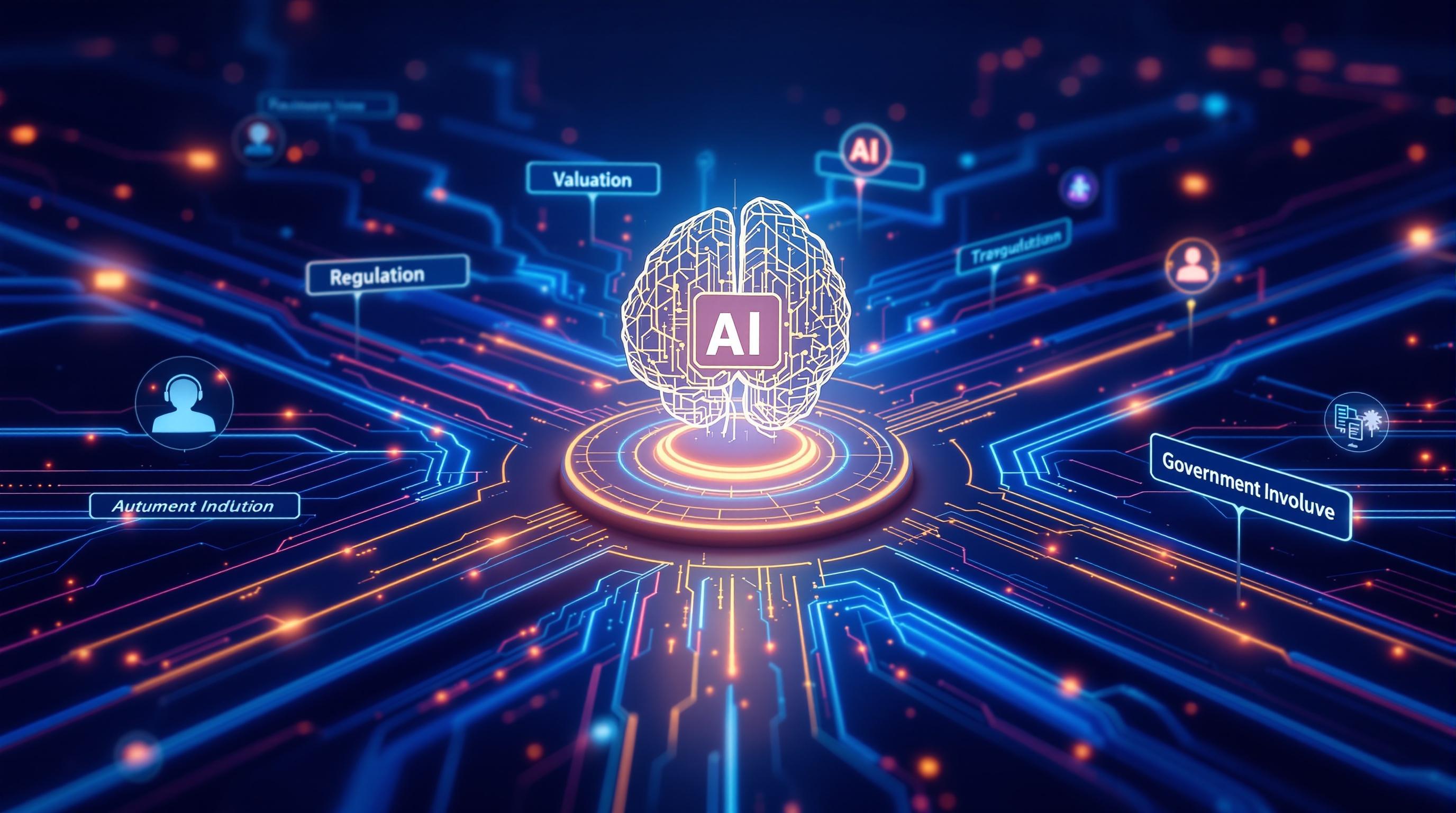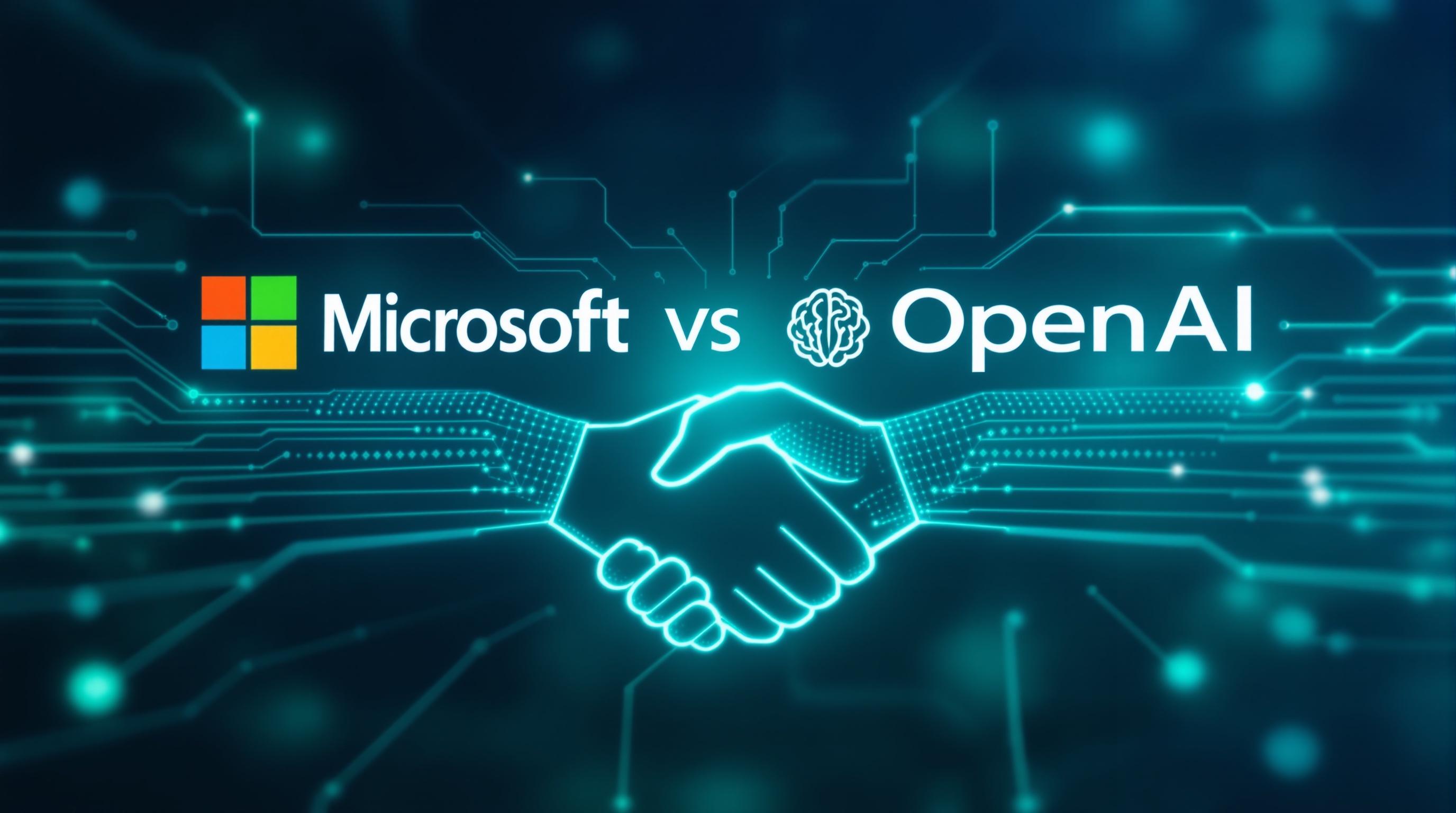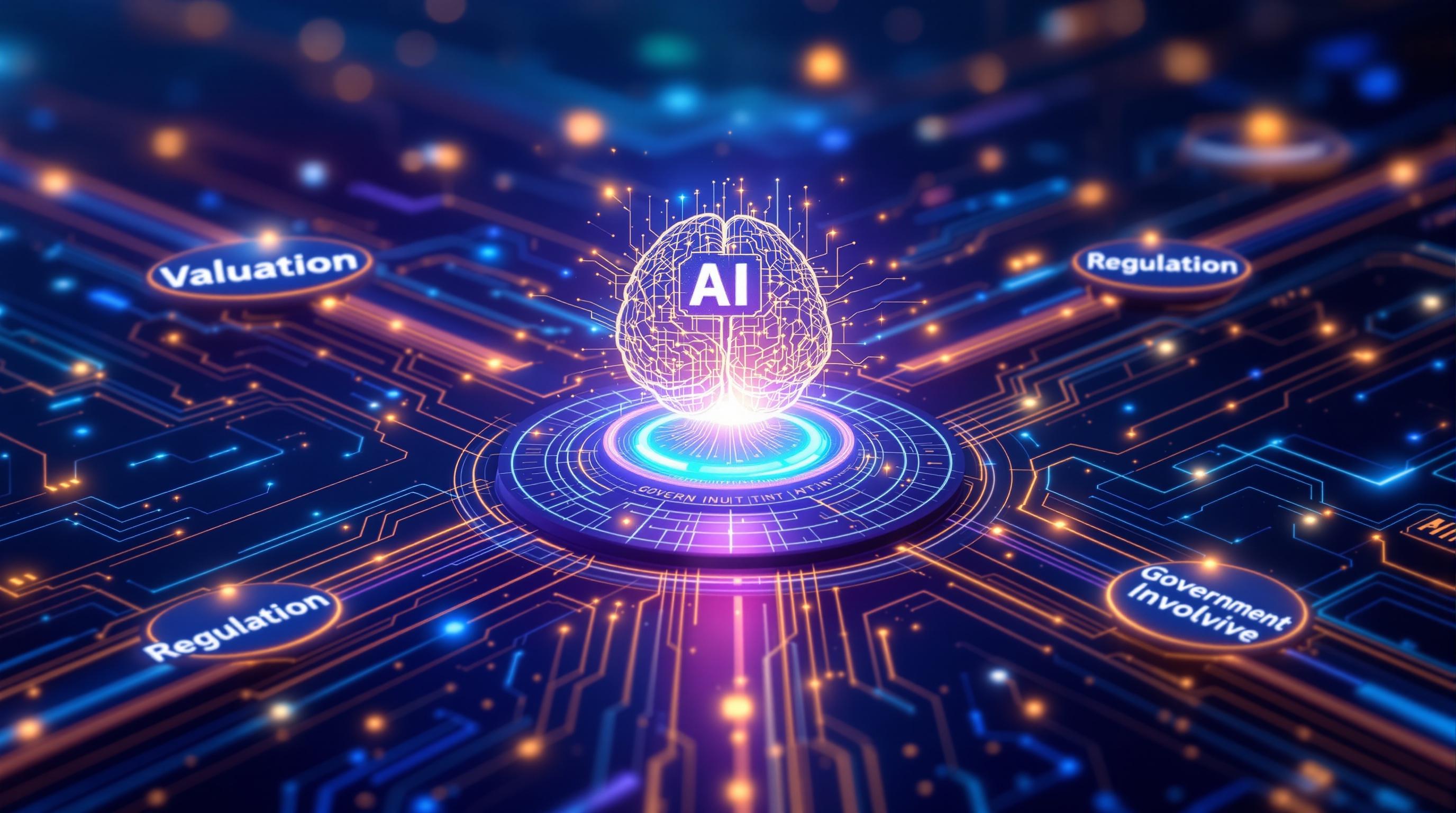OpenAI’s $500B Valuation, US Buys Into Intel & The Great AI Stock Pullback – AI News, August 20, 2025

Dive into the AI revolution as valuations, regulations, and government involvement redefine the tech landscape. Discover how these shifts impact investment strategies and business integration, and gain insights on navigating the evolving AI market for sustained success. Stay ahead by leveraging practical AI applications and proactively addressing talent gaps to thrive in this new era.
OpenAI Reaches Stratospheric $500 Billion Valuation: What's Driving the AI Boom?
The artificial intelligence landscape is evolving at warp speed, and OpenAI's recent valuation is a testament to this explosive growth. In a landmark secondary stock sale, the company reached a staggering $500 billion valuation, solidifying its position as a frontrunner in the AI revolution.
The Power Players Behind the Deal
The transaction saw prominent investment firms like SoftBank, Thrive Capital, and Dragoneer Investment Group acquiring shares in OpenAI. These are not just passive investors; they're key players known for spotting and nurturing tech giants. Their involvement underscores the immense confidence in OpenAI's long-term potential and strategic direction. Think of it like a vote of confidence, but with very deep pockets!
A Meteoric Rise in Valuation
What's truly astonishing is the speed at which OpenAI's valuation has skyrocketed. This $500 billion figure represents a 67% increase from the company's previous valuation of $300 billion in March of the same year. Such rapid appreciation is virtually unheard of, even in the fast-paced world of tech startups. This kind of growth usually indicates significant fundamental shifts, rather than just market hype.
The ChatGPT Phenomenon and Beyond
So, what's fueling this extraordinary valuation? The answer largely lies in the phenomenal success of ChatGPT, OpenAI's flagship product. This conversational AI has captured the world's attention, boasting an impressive 700 million weekly users. The anticipation surrounding the launch of GPT-5, the next iteration of their groundbreaking language model, is also a major contributing factor. It's like the anticipation before a new iPhone launch, but for AI, and with potentially even bigger implications.

Revenue Triples: AI's Bottom-Line Impact
The impressive user base and technological advancements have translated into substantial revenue growth for OpenAI. The company's annual revenue has tripled to $12.7 billion, demonstrating AI's increasing move from experimental projects to core business infrastructure. This kind of revenue validates that AI is not just a flashy new technology, but a legitimate business driver.
Navigating the Competitive Terrain
Of course, OpenAI isn't operating in a vacuum. The competitive landscape is fierce, with tech giants like Apple and Google making significant investments in AI. However, OpenAI's first-mover advantage and its proven ability to innovate give it a distinct edge. The company also actively uses tools such as Grok, an AI chatbot, for strategic insights. Staying ahead requires constant innovation and a keen understanding of the market dynamics.

Addressing the AI Talent War
The surge in AI development has ignited a fierce competition for top talent. OpenAI has been strategically navigating this talent war, attracting and retaining some of the brightest minds in the field. Acknowledging and resolving talent gaps is imperative for the sustained innovation and competitive advantage of any AI organization.
Validating AI's Business Integration
Ultimately, OpenAI's soaring valuation is more than just a number. It validates the broader trend of AI moving into core business infrastructure. Companies are increasingly recognizing the potential of AI to drive efficiency, enhance decision-making, and create new revenue streams. The success of OpenAI's products, like DALL-E 3, an AI image generator, proves the value in this technology. This signals a fundamental shift in how businesses operate, with AI becoming an indispensable tool for success. As AI continues to mature, we can expect even greater integration across various sectors, further fueling the AI boom. Stay up to date with the latest trends by checking out AI News for daily updates.

AI Stock Correction: Nvidia, Palantir Plunge as Market Sentiment Shifts
The AI stock market is no stranger to volatility, but recently, the sector experienced a significant correction that sent ripples throughout the tech world.
The Great AI Selloff
The correction was broad, but certain stocks felt the impact more acutely. Nvidia, the chipmaking giant that has become synonymous with the AI boom, and Palantir, the data analytics firm known for its government contracts, led the selloff. Both companies experienced sharp declines, prompting investors to reassess their positions in the market.
Unsustainable Valuations Under Scrutiny
At the heart of the correction lies the issue of valuation. The market had begun to deem the valuations of several AI stocks as unsustainable. The rapid ascent of these companies, fueled by hype and speculative investment, faced increasing investor scrutiny. Palantir, in particular, came under the microscope due to its high price-to-earnings (P/E) ratio. While the company has demonstrated strong growth, some analysts questioned whether its valuation was justified. Similarly, Nvidia's earnings multiple, although supported by robust financial performance, was perceived by some as stretched, leaving little room for error.
Palantir in the Crosshairs
Concerns surrounding Palantir intensified as short interest in the stock surged. This indicated a growing sentiment among investors that the stock was overvalued and poised for a decline. Adding fuel to the fire, Citron Research issued a report that compared Palantir unfavorably to OpenAI, the company behind ChatGPT, a revolutionary AI chatbot that has changed the way we interact with computers. Citron argued that Palantir's valuation was excessive and suggested a much lower fair value for the stock. The report further stoked the concerns of investors, contributing to the selloff.
A Shift in Investment Strategy
The recent correction signals a broader shift in investment strategy within the AI sector. Investors are moving away from purely speculative investments and adopting a more value-based assessment approach. This involves a deeper analysis of a company's fundamentals, including its revenue growth, profitability, and competitive positioning. Companies with solid financial metrics and sustainable business models are likely to weather the storm, while those built on hype alone may struggle to maintain their lofty valuations. This shift also highlights the importance of separating sustainable AI businesses from potential bubble companies. For instance, companies leveraging AI in practical applications, such as Salesforce Platform for business solutions, are viewed differently than companies with speculative, future-oriented promises.
Ultimately, the AI stock correction underscores the importance of diligence and rational investment. As the AI landscape continues to evolve, investors must remain vigilant, focusing on long-term value creation rather than short-term gains. This correction could pave the way for a healthier, more sustainable AI market, which will be interesting to follow in our AI News section.

Government Equity in Tech: U.S. Takes 10% Stake in Intel Using CHIPS Act Funds
The landscape of technology investment is undergoing a seismic shift, with governments increasingly seeking equity stakes in strategic companies.
U.S. Government's Bold Move: Taking an Equity Stake in Intel
In a move that has sent ripples through the tech world and Wall Street, the U.S. government is pursuing a 10% equity stake in Intel through grants allocated via the CHIPS Act. This landmark legislation, aimed at bolstering domestic semiconductor production, is now being used in a way few anticipated: to directly convert federal grants into stock ownership. The initial investment involves $7.8 billion in grants, a substantial sum that will translate into a significant ownership position. By converting these grants into equity, the federal government is poised to become one of Intel's largest shareholders, if not the largest.
'America Gets the Benefit of the Bargain': Justification for Equity
The strategy behind this unprecedented move is straightforward, according to administration officials: ensuring 'America gets the benefit of the bargain.' The idea is that taxpayers should directly benefit from the success of companies receiving public funds, not just through job creation and economic growth, but also through a share in the companies' profits and long-term value appreciation. This approach contrasts sharply with traditional grant models, where the government provides funding without any direct claim on the recipient's future earnings or assets. This bold move also opens the door to new forms of public-private partnership that can better align the interests of government and industry. This will also allow the US government to avoid issues where they provide funding without getting any influence over the company's direction, as had been the case with OpenAI.
Expanding the Equity Model: Micron, TSMC, and Samsung
But Intel is just the beginning. The U.S. government is reportedly exploring similar equity arrangements with other major semiconductor manufacturers, including Micron, TSMC, and Samsung. These companies are all potential recipients of CHIPS Act funding, and the government sees an opportunity to replicate the Intel model, securing equity stakes in these firms as well. The specifics of these arrangements are still under negotiation, but the overarching goal is clear: to create a portfolio of government-held equity in key strategic tech companies. The government hopes to leverage innovative AI tools like Grok, developed by xAI, for more precise market forecasting and strategic decision-making in managing these investments.
Unprecedented Public-Private Partnerships
These potential equity deals represent an unprecedented level of public-private partnership, blurring the lines between government and corporate ownership. It's a significant departure from the traditional arms-length relationship between the state and the private sector, and it raises important questions about the role of government in the economy. Some analysts see this as a necessary step to counter aggressive industrial policies pursued by other countries, particularly China, in the semiconductor industry. Others worry about the potential for political interference in corporate decision-making and the risks of government overreach. How the government handles these relationships will be critical to the success of this initiative.
Accelerating Domestic Semiconductor Production
Proponents argue that these equity investments will accelerate the reshoring of semiconductor production to the United States. By having a direct financial stake in these companies, the government has a stronger incentive to ensure their success, which could translate into more favorable regulatory treatment, streamlined permitting processes, and other forms of support. This hands-on approach could help overcome some of the obstacles that have historically hindered domestic manufacturing efforts, such as high labor costs and complex supply chains.
Reshaping American Capitalism
Ultimately, the U.S. government's pursuit of equity stakes in tech companies represents a potential reshaping of American capitalism. It marks a move away from the purely free-market model towards a more interventionist approach, where the government plays a more active role in shaping the economy and directing investment. This shift raises fundamental questions about the appropriate balance between public and private control, the role of government in promoting innovation, and the future of American economic competitiveness. Only time will tell if this bold experiment will succeed, but one thing is certain: it marks a watershed moment in the relationship between government and technology.

Fed's AI Dilemma: Balancing Infrastructure Needs and Housing Market Concerns
The Federal Reserve finds itself walking a tightrope in 2025, balancing the urgent demands of a rapidly evolving AI landscape with the more traditional, yet still critical, concerns of the housing market. This convergence of technological advancement and economic fundamentals presents a unique and complex challenge for monetary policy.
Housing Market Blues: A Two-and-a-Half-Year Low
The housing market is currently facing significant headwinds. Homebuilder sentiment has plummeted to a two-and-a-half-year low, a clear indicator of the struggles within the sector. The primary culprit? Persistently high mortgage rates. These elevated rates are keeping potential homebuyers on the sidelines, suppressing demand and creating a ripple effect throughout the housing industry. This situation presents a classic economic problem: how to stimulate a vital sector without destabilizing the broader economy.
The AI Capital Expenditure Conundrum
On the other side of the equation, the burgeoning AI industry is poised for massive capital expenditures. Lowering interest rates, while potentially beneficial for the housing market, could inadvertently fuel an AI-driven investment boom of unprecedented proportions. This surge in spending, while driving innovation and technological progress, also carries the risk of overshooting inflation targets. The sheer scale of AI infrastructure development, particularly the construction of sprawling data centers, demands trillions of dollars in investment. Consider, for instance, the resources needed to power advanced AI models like GPT-4o and Google Gemini, requiring massive computing power and energy consumption. This necessitates a delicate balancing act to ensure sustainable economic growth without triggering inflationary pressures.
Deficits and Monetary Policy: A Complicated Picture
Adding another layer of complexity to the Fed's dilemma is the state of federal deficits, which are currently exceeding 6% of GDP. Such substantial deficits limit the flexibility of monetary policy and make it more challenging to effectively manage economic cycles. The increased government borrowing can put upward pressure on interest rates, further complicating the efforts to stimulate the housing market. Furthermore, the inflationary impact of large deficits could be exacerbated by an AI-driven capital expenditure boom, creating a perfect storm of economic challenges.
Economists' Warnings: Overheating the Economy
Leading economists are sounding the alarm, cautioning that cutting interest rates in the current environment could lead to an overheated economy. The unique capital demands of the AI sector, coupled with already high federal deficits, create a scenario where even modest rate cuts could trigger a surge in investment and spending, pushing inflation well above the Fed's target. This perspective emphasizes the need for a cautious and data-driven approach to monetary policy, carefully weighing the potential risks and rewards of each decision.
Traditional Housing vs. Digital Transformation: A New Era
The Fed's challenge ultimately boils down to prioritizing traditional housing concerns against the infrastructure needs of a rapidly evolving digital economy. While a healthy housing market is crucial for economic stability and individual prosperity, the transformative potential of AI cannot be ignored. Investing in AI infrastructure is essential for long-term competitiveness and economic growth. As AI models become increasingly sophisticated, like DeepSeek, known for its coding capabilities, the demand for robust infrastructure will only intensify. The Fed must navigate this complex landscape, finding a path that supports both the immediate needs of the housing market and the long-term demands of the digital revolution. This requires a nuanced understanding of the interplay between monetary policy, technological innovation, and fiscal responsibility, ensuring a stable and prosperous future for all. Keeping up-to-date with AI News will be essential for navigating this rapidly changing landscape.

Microsoft-OpenAI Partnership Renegotiation: The Future of Enterprise AI
The AI landscape is shifting, and one of the most significant indicators is the ongoing renegotiation of the partnership between Microsoft and OpenAI, which signals a pivotal moment for the future of enterprise AI.
The Stakes: Equity and Continued Access
At the heart of these discussions is Microsoft's pursuit of a substantial equity stake in OpenAI, reportedly in the range of 30-35%. This isn't just about financial investment; it's about solidifying Microsoft's position in the AI ecosystem for the long haul. Microsoft wants to ensure they continue to have access to OpenAI's cutting-edge technology, especially as we approach and potentially surpass Artificial General Intelligence (AGI) milestones. This access is paramount for Microsoft, as it allows them to integrate these advancements into their own product offerings and cloud services, ultimately benefiting their enterprise customers.
A $14 Billion Bet and Azure's AI Future
Microsoft's commitment to OpenAI is already substantial, with a $14 billion investment fueling much of OpenAI's research and development. This investment has enabled the creation of powerful AI models like ChatGPT, a versatile conversational AI, that are now integral to Microsoft's Azure Machine Learning services. Azure OpenAI Service allows businesses to leverage these advanced AI capabilities for various applications, from customer service chatbots to complex data analysis tools. A renegotiated partnership aims to protect this investment and guarantee that Azure remains at the forefront of AI-powered cloud solutions.
Navigating Regulatory Waters and Legal Challenges
The path to solidifying this partnership isn't without its challenges. Increased regulatory scrutiny of AI deals, particularly those involving major tech players, adds complexity to the negotiations. Furthermore, Elon Musk's ongoing lawsuits against OpenAI, alleging a departure from its original non-profit mission, injects further uncertainty into the equation. These external pressures necessitate careful navigation to ensure the partnership adheres to evolving legal and ethical standards.
Implications for Cloud Computing Dominance
This renegotiation has significant implications for the broader cloud computing landscape. If Microsoft successfully secures a larger equity stake and guarantees continued access to OpenAI's technology, it could further solidify its dominance in the cloud AI market. This could put pressure on competitors like Google Cloud AI and Amazon Web Services to strengthen their own AI offerings and partnerships. The competition for cloud supremacy is intensifying, and AI is proving to be a crucial battleground.
Redefining AI Industry Partnerships
Ultimately, the outcome of the Microsoft-OpenAI partnership renegotiation will likely set a precedent for future AI industry collaborations. It will shape how technology companies structure their relationships with AI developers, how intellectual property is managed, and how access to advanced AI capabilities is distributed. This is more than just a deal; it's a blueprint for the future of AI partnerships, balancing innovation, investment, and control. As AI News continues to develop, the ripples of this agreement will undoubtedly be felt across the entire tech sector.

AI's Inflection Point: New Era of Valuation, Regulation, and Government Involvement
The relentless march of artificial intelligence is no longer a disruptive sideshow; it's the main event. We're witnessing AI's transition from a groundbreaking technology to a firmly established industry, a pivotal shift that demands entirely new ways of thinking about valuation, regulation, and the role of government. It’s like watching a startup transform into a Fortune 500 company – the rules of the game change drastically.
The Maturing Market: OpenAI's Valuation and the AI Stock Correction
The signals are clear: AI is growing up. OpenAI, the company behind ChatGPT, is a revolutionary AI chatbot and one of the most well known AI tools. The valuation of OpenAI at a staggering $500 billion underscores the immense potential – and the immense hype – surrounding the field. But this figure, coupled with the recent correction in AI stocks, highlights a critical point: the market is beginning to mature. The days of unrestrained exuberance are fading, replaced by a more sober assessment of long-term value and sustainability. Investors are now demanding more than just promises; they want tangible results and clear paths to profitability.
A Wartime Echo: Trump's Intel Stake Proposal
Perhaps one of the most striking indicators of AI’s newfound status is the Trump administration's proposal to take a stake in Intel. This isn't just about economic policy; it’s a move that echoes wartime-era industrial strategies, where the government directly intervened to secure access to critical technologies. Imagine the government deciding to invest heavily in railroads during the Civil War – that’s the scale of the shift we’re seeing. This proposal signifies a recognition that AI, and the infrastructure that supports it, is a matter of national security, and that traditional market forces alone may not be sufficient to guarantee American dominance. The idea of the government becoming a significant shareholder in a major tech company raises complex questions about control, innovation, and the balance between public and private interests.
The Fed's Infrastructure Dilemma
This government involvement extends beyond specific companies. The Federal Reserve faces a novel challenge: how to account for the unprecedented infrastructure demands of the AI era. The sheer scale of computing power required to train and deploy advanced AI models necessitates massive investments in data centers, energy grids, and specialized hardware. How does the Fed factor this into its monetary policy? Can traditional economic models accurately capture the impact of these infrastructure investments? It’s like trying to apply 1950s economic theory to the internet age – the old rules simply don't apply. This dilemma creates new economic challenges and forces policymakers to grapple with the unique characteristics of the AI revolution.
A Permanent Fixture
2025 marks the year AI firmly entrenches itself as a permanent fixture of American economic policy. From direct government investment to novel regulatory frameworks and the Fed's infrastructure considerations, AI is no longer a fleeting trend; it's a fundamental force shaping the nation's economic future. This transformation necessitates a proactive and nuanced approach, one that balances the immense potential of AI with the need for responsible oversight and sustainable growth. Understanding these shifts is crucial for anyone seeking to navigate the evolving landscape of AI and its impact on our world. Monitoring AI News will be crucial to understanding the impacts of AI in the future.
🎧 Listen to the Podcast
Hear us discuss this topic in more detail on our latest podcast episode: https://creators.spotify.com/pod/profile/bestaitools/episodes/OpenAIs-500B-Valuation--US-Buys-Into-Intel--The-Great-AI-Stock-Pullback--AI-News--August-20--2025-e372tbh
Keywords: OpenAI valuation, AI stock correction, Intel government stake, AI infrastructure spending, Microsoft OpenAI partnership, ChatGPT users, GPT-5 launch, Nvidia stock, Palantir stock, CHIPS Act, Federal Reserve AI dilemma, AI investment, AI market trends, AI economic impact, AGI
Hashtags: #AI #ArtificialIntelligence #OpenAI #TechNews #Investment
For more AI insights and tool reviews, visit our website https://best-ai-tools.org, and follow us on our social media channels!
Website: https://best-ai-tools.org
X (Twitter): https://x.com/bitautor36935
Instagram: https://www.instagram.com/bestaitoolsorg
Telegram: https://t.me/BestAIToolsCommunity
Medium: https://medium.com/@bitautor.de
Spotify: https://creators.spotify.com/pod/profile/bestaitools
Facebook: https://www.facebook.com/profile.php?id=61577063078524
YouTube: https://www.youtube.com/@BitAutor
Recommended AI tools
Nomi.ai
Conversational AI
Empowering AI Conversations
StockCake
Image Generation
Baking the perfect stock analysis for you
StockStory
Data Analytics
Uncover the narrative behind the numbers.
AInvest
Data Analytics
Empowering your investment decisions with AI
EarnBetter
Productivity & Collaboration
Maximize Your Earnings with EarnBetter
Intapp DealCloud
Data Analytics
Find, win, and execute more business with Intapp DealCloud


